Even wine novices who can barely tell a Cabernet Sauvignon from a Cabernet Franc know something about Bordeaux. It’s one of the most famous wine regions in the world, a paragon of history and quality that inspires winemakers everywhere. Bordelais blends, especially the red ones, serve as models for similar wines produced in California, Chile, South Africa, and Australia. It’s one of the reasons for the universal popularity of Merlot and Cabernet Sauvignon, and helps raise awareness of the other classic Bordeaux grapes Cabernet Franc, Malbec, and Petit Verdot.

But stocking your cellar with bottles of top-tier Bordeaux can put a dent in your wine budget – a BIG dent! And, even if you can afford them, many of the classic wines need a few years of bottle age before they show their best qualities. So, what’s a claret-loving oenophile with limited funds to do? I say, Go to Côtes de Bordeaux!
Note: the wines featured in this post were provided to me as media samples. All thoughts and opinions are my own.
Michelle Williams of RockinRedBlog hosts the French Winophiles this month, and we’re headed to AOC Côtes de Bordeaux, a coalition of five small regions making red, white, and dessert wines on the right bank of Bordeaux. To learn more about our topic, check out Michelle’s preview post here .
Red wine is king in the Côtes, comprising 97% of production, and depends on familiar grapes like Merlot and the Cabernets; white wines come from Sauvignon Blanc and Sémillon. The best reasons to learn more about these wines? They’re affordable – many are priced around $20 – and they are ready to drink the day you buy them. Win-win, don’t you think?
If you’d like to participate in our Côtes de Bordeaux chat, here’s what to do: log into Twitter at 11 a.m. ET Saturday, May 19th and search for #Winophiles. You’ll be able to follow the conversation and jump in wherever you like. Just remember to add #Winophiles to your tweets so we can welcome you. You can look forward to tasting notes, menu pairing ideas, travel stories, and more. It’s always great fun! Here’s a teaser of what all the bloggers will contribute:
Robin of Crushed Grape Chronicles shares “Côtes de Bordeaux pairings through Blaye, Cadillac & Castillon”
Camilla of Culinary Adventures with Camilla offers “Exploring the Côtes de Bordeaux with Simple, Salty, Spicy Nibbles”
Wendy from A Day in the Life on the Farm shares “Celebrating the Warm Weather with Bordeaux”
David from Cooking Chat brings us “Cheesy Beef Casserole with Wine from Côtes de Bordeaux”
Nicole from Somm’s Table explores “2 oz Pours: 5 Nights of BDX”
Martin from Enofylz Wine Blog offers “Côtes de Bordeaux: Your Go-To For Affordable, Approachable Bordeaux”
Gwen from Wine Predator shares “Affordable French: Bordeaux and Burgers for #Winophiles”
Rupal the Syrah Queen gives us “5 Reasons You Should Be Drinking Côtes de Bordeaux”
Jill of L’Occasion offers a “Guide to the Wines of Côtes de Bordeaux”
Lynn of Savor the Harvest shares “Côtes de Bordeaux: A Chateau Carsin Surprise”
Jeff at FoodWineClick! shares “Drinking Tuesday Night Bordeaux”
Liz Barrett of What’s In That Bottle helps us with “Get to Know Côtes de Bordeaux #Winophiles”
Amber of Wine Travel Eats gives us “Salmanazar – Côtes de Bordeaux”
Michelle from Rockin’ Red Blog will be sharing “Drinking Bordeaux in Blue Jeans”
And here at The Swirling Dervish we offer “Côtes de Bordeaux: Why It Should Be on Your Wine Shopping List”
What and Where Is AOC Côtes de Bordeaux?

Côtes means “slopes” in French, and most of the vineyards in Côtes de Bordeaux lie on slopes extending up from the banks of the Garonne and Dordogne Rivers. The five zones that make up the AOC are separate and distinct from each other, with different soils, elevations, and climates. Some make only red wine, others make red, white, and dessert wines. But all of the zones deliver wines with a high quality-price ratio (QPR) and are ready to open for dinner tonight. Let’s look at each of the Côtes one by one:
Blaye Côtes de Bordeaux
Blaye lies across the Gironde River, directly across from the Medoc, home to some of the world’s most thirsted-after red wines. Ninety percent of production is red, and Merlot dominates the plantings (70%) followed by Cabernet Sauvignon (20%) and Malbec (10%). White wines are also made in Blaye, mostly from Sauvignon Blanc (90%) with minor plantings of Muscadelle and Sémillon (10% combined).
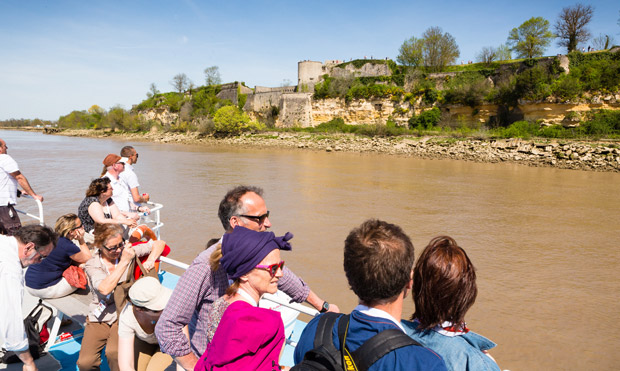
Wine estates tend to be family affairs, as is the case in most of the Côtes, with the average holding around 15 hectares (37 acres). The region has become known for its embrace of modern winemaking techniques and its dynamic approach to classic Bordeaux blends.
Cadillac Côtes de Bordeaux
Cadillac extends as a long, narrow ribbon along the right bank of the Garonne River. This is strictly red wine country, with a reputation for refined, elegant wines. All Cadillac Côtes de Bordeaux wines are estate-bottled even though individual holdings average just 9 hectares per producer. Merlot is a little less dominant here (only 55% of plantings) while Cabernet Sauvignon makes up a quarter of area under vine. Cab Franc (15%) and Malbec (5%) round out the offerings.

Castillon Côtes de Bordeaux
A smaller pocket lying just west of the celebrated terroir of Saint-Emilion, Castillon also abuts the Dordogne River to its south. As in the prestigious vineyards nearby, Cabernet Sauvignon takes a back seat (only 10% of production) to Merlot (70%) and Cabernet Franc (20%). That shift in the plantings is reflected in the personality of the wines: they are rounder and less tannic, with lovely plum and berry aromas. Castillon wines also tend to be silkier in texture, with complex, intense flavors. And they’re meant to be enjoyed upon release.
Francs Côtes de Bordeaux
A tiny terroir situated at the northeastern tip of Castillon, Francs offers a full menu of Bordeaux wines: reds are based on Merlot (60%) Cabernet Sauvignon (25%) and Cabernet Franc (15%). Whites here depend largely on Sémillon (60%) Sauvignon Blanc (32%) and Muscadelle (8%). At just over 1,000 acres, Francs Côtes de Bordeaux puts out tiny quantities of wine compared to the other regions, and these bottles (especially the dessert wines) are prized for their scarcity.
Sainte-Foy Côtes de Bordeaux
At just 865 acres total, Sainte-Foy is the smallest as well as the newest region of the Côtes. While the other areas had unified in 2009, Sainte-Foy joined the appellation in 2016. It’s another area that makes red, white, and dessert wines, although production centers around dry reds. Merlot (65%) and the Cabs (17% and 15%) dominate plantings, with a tiny bit of Malbec (3%) in the mix. Sauvignon Blanc is the most important white grape (60%) with Sémillon next (30%) and Muscadelle (10%). Red wines from Sainte-Foy are known for their intense cherry aromas and flavors.
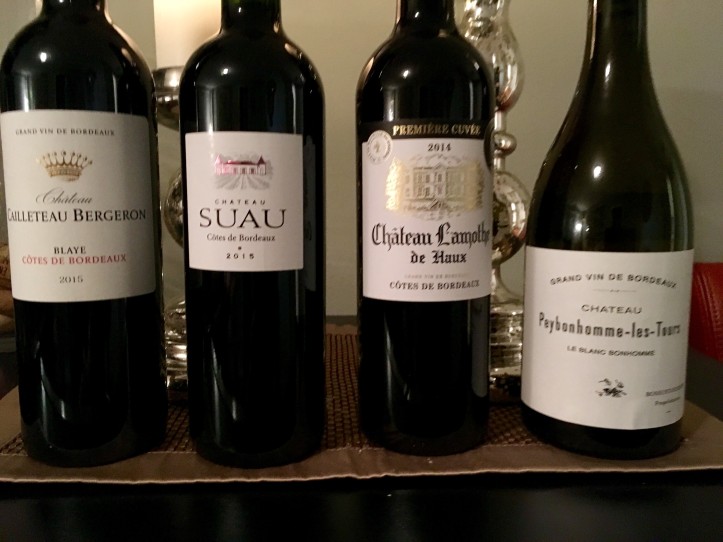
Why Should I Buy Côtes de Bordeaux Wines?
Now that you’ve learned a little about what they are and where they come from, it should be easy to see that these wines share a lot in common with their cousins from more famous terroirs. In some cases, a river or a hillside is all that separates one from another. Granted, when we’re talking about wine, such things matter greatly. In fact, some aficionados might say they’re all that matters.
But I’m talking real wines here, bottles average folks like us can open on a weeknight to celebrate that it’s Wednesday, or that the kids are with your parents. They’re everyday wines for everyday life. And there’s even more to love about them than the price:
- Most are labeled with the grape variety, making it easy to know what’s in the bottle.
- They’re ready to drink today, although some may improve over a few years.
- There’s little or no oak influence, making them easy to pair with food.
- Most are made by family-owned estates.
- Sustainable, organic, and biodynamic methods are common.
- Locals refer to these wines as “Bordeaux in Blue Jeans,” which says it all.
- Drink a wine, love it, then visit the grower who made it. Wine tourism is big in Côtes de Bordeaux.

My Recommendations
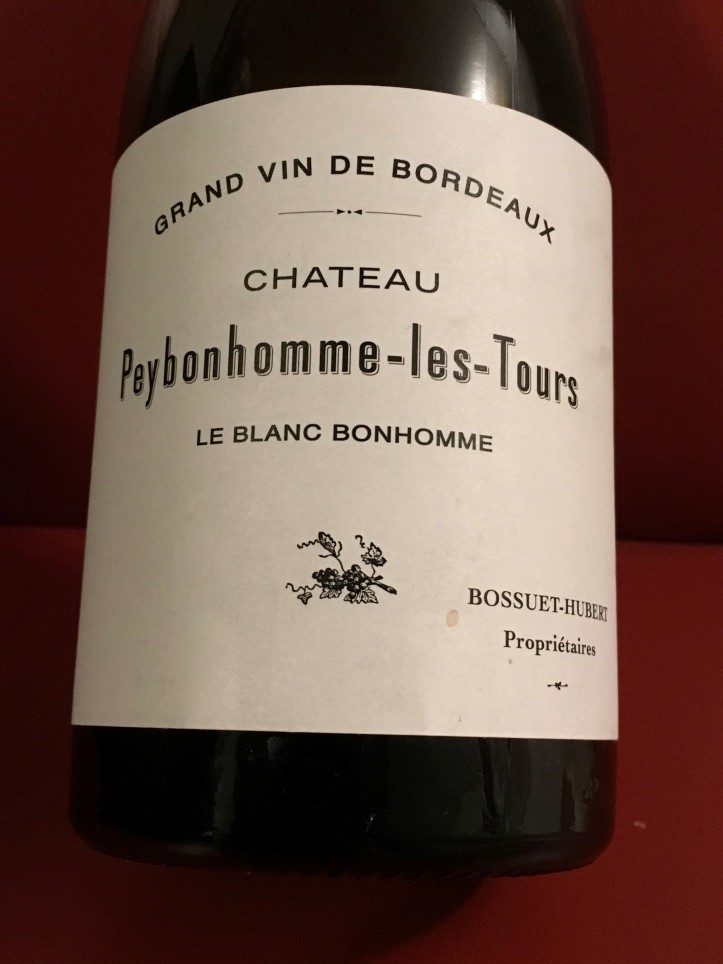
2016 Château Peybonhomme-Les-Tours Le Blanc Bonhomme AOC Blaye Côtes de Bordeaux
50% Sauvignon Blanc; 50% Sémillon
13.5% abv; suggested retail price $20
Importer: Summit Selections
Château Peybonhomme-Les-Tours is the largest certified biodynamic estate in Blaye. It’s run by Guillaume and Rachel Hubert, siblings who represent the fifth generation of their family to farm the vines and make the wines. Some of the wine (40%) was fermented in neutral oak barrels, the rest in concrete tanks, and it underwent daily lees-stirring for five weeks, then twice weekly until settling.
Color: Medium lemon, fading to pale lemon at the edge.
Nose: Medium-intensity aromas of lemon and white flowers, with a subtle savory note of wool or lanolin. A whisper of vanilla-lemon cream.
Palate: Medium+ acidity, with flavors of lemon, orange, and pear; a haunting trace of honey. Medium+ body, with a long faintly bitter finish that ends on a slightly sweet-herbal note. There is a bit of beeswax texture to it as well.
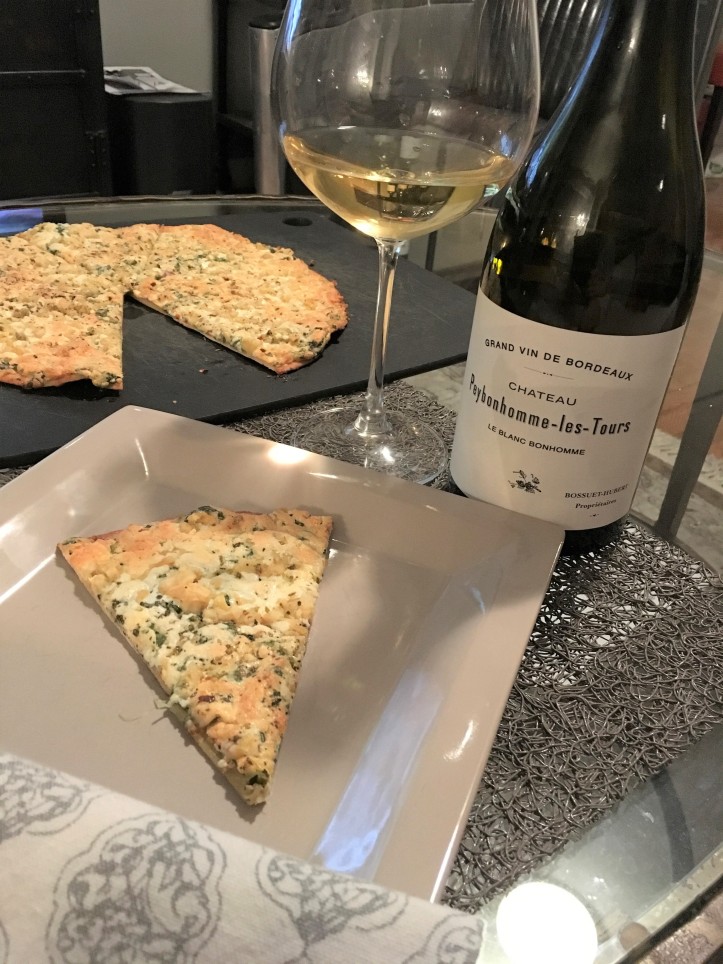
Verdict: A beautiful wine – this blew me away! It was well-balanced, complex, and delicious. I usually perfer my white Bordeaux with a bit more Sémillon in the mix. This one, though, was just perfect. I could drink this every day!

2015 Château Cailleteau Bergeron AOC Blaye Côtes de Bordeaux
90% Merlot; 10% Cabernet Sauvignon
13.5% abv; suggested retail price $19.99
Importer: Demontoux Fine Wines (sorry, no website available)
Another estate led by a brother-sister team, Cailleteau Bergeron has evolved over four generations from five acres plowed by their great-grandfather, to a sustainable biodiverse holding of 95 acres. The vineyards are certified by Terra Vitis.
Grapes from individual plots are fermented in small vats and macerated for three weeks. The Merlot ages in cement vats, while the Cabernet Sauvignon lies in new French oak for 15 months.
Color: Deep ruby, with violet flashes at the edge.
Nose: Medium+ aromas of black fruit – ripe but not jammy, with complementary notes of baking spice and vanilla. A little cedar pops up after an hour.
Palate: All the fruit of the nose, especially black cherry and sweet plum. Acidity is moderate, with smooth tannins, and medium body. The finish is long, with subtle notes of clove and licorice.

Verdict: This is a perfect red wine for people who think they don’t like red wine. Lovely flavors, smooth tannins are inviting, and make it a nice match for simply grilled meat and a fresh salad. I’d drink this on its own, too, with a friend; or maybe just by myself. 😊

2014 Château Lamothe de Haux Première Cuvée AOC Cadillac Côtes de Bordeaux
60% Merlot; 30% Cabernet Sauvignon; 10% Cabernet Franc
13% abv; suggested retail price $15
Importer: Steep Hill Imports
One of the original players in Cadillac, Château Lamothe has made and bottled wine here since the 16th century. Since then, the estate has remained family-owned, passed down to successive generations matrilineally, bringing us to the Chombart family who has run the property since 1956. It’s a distinctive presence in the region, with its limestone quarries that have been renovated into underground cellars, and the iconic château itself, which is featured on the label. Encompassing 190 acres of clay and limestone soils, Château Lamothe practices sustainable agriculture and is certified by the Environmental Management System.
This wine was fermented and macerated for two to three weeks and was aged in oak: 30% new, and 70% second-use, for one year.
Color: Deep ruby red; it looks like velvet.
Nose: Intense aromas of red and black fruit: cherry, plum, currants; subtle vanilla, cedar, and graphite notes. Really enticing!
Palate: Ripe red and black fruit, more cherry and plum than currant; baking spice, chai tea. Medium acidity, medium silky tannins, medium body.

Verdict: This is a soft, easy, agreeable wine that would be a great welcome after a long, tough day. Pair it with turkey chili or a grilled chicken breast for a weeknight comfort-food meal.

2015 Château Suau AOC Cadillac Côtes de Bordeaux
70% Merlot; 20% Cabernet Sauvignon; 10% Cabernet Franc
13% abv; suggested retail price $25
Importer: Kysela Pere & Fils
Château Suau sits atop the highest point in Cadillac, expanding over 163 acres at 330 feet. Acquired by Monique Bonnet in 1986, the property began the conversion to organic farming in 2008. Since the 2014 vintage, all wines have been produced under the aegis of flying winemaker Michel Rolland, and are classified under Ecocert.
Grapes were destemmed and sorted, then underwent fermentation in temperature-controlled stainless steel tanks. The wine aged in 100% French oak barrels for 12 months.
Color: Medium ruby, with a pink edge.
Nose: Medium+ intensity black fruit aromas: plum, black currant, black cherry, accented by a little vanilla and spice.
Palate: Medium tannins and acidity, with a melange of red and black fruit flavors. The wine isn’t sweet but I did get a ribbon of vanilla-sugar in the mid-palate, followed by a tart bit of cherry pie filling on the finish.
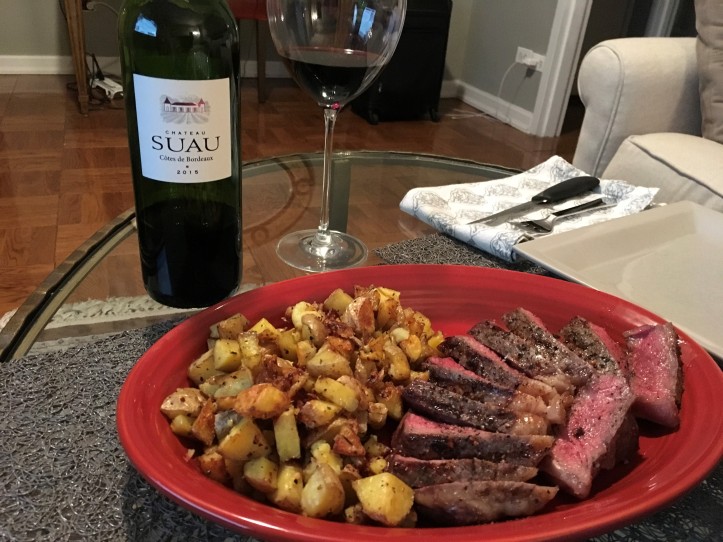
Verdict: Another easy-to-pair wine that would go well with almost any dish: grilled meat would be excellent, as would roast chicken. It’s practically impossible not to like this wine.
Thanks to the producers of Côtes de Bordeaux and Teuwen Communications for making these wines available as samples, and for providing data on the region’s history and winemaking traditions. It has been a pleasure to learn more about these affordable, approachable wines that are perfect for every day!
About the French Winophiles
We’re a group of wine-loving foodies who gather (virtually) on the third Saturday of the month to share wine-pairing ideas, travel stories, and tasting notes on a particular theme. New members are always welcome so, if you’re interested in joining us, we’d love to have you. In June we head to the sunny slopes of Alsace with our host, Michelle Williams of Rockin’ Red Blog fame. Should be a fun trip!
Great information Lauren. So thorough. And your pairings look great. Thank you for sharing.
LikeLiked by 1 person
Thanks Michelle – great topic this month! So many different wines all leading to the same conclusion – high-quality, affordable, and delicious. And thanks again for hosting.
LikeLiked by 1 person
Great food pairings, and I was super impressed with the Peybonhomme blanc as well. Delicious!
LikeLiked by 1 person
Sounds like it was stand-out among those who received it. I’ll be tracking down some additional bottles!
LikeLike
[…] Lauren from The Swirling Dervish offers “Côtes de Bordeaux: Why It Should Be on Your Wine Shopping List” […]
LikeLike
[…] Lauren from The Swirling Dervish offers “Côtes de Bordeaux: Why It Should Be on Your Wine Shopping List” […]
LikeLike
Found your overview on each of the areas helpful. There are just so many wines in Bordeaux, let alone the Côtes, nice to read your reviews. And on that note, since spring is in the air, I’ll be searching out Le Blanc Bonhomme from Ch Peybonhomme-Les-Tours!
LikeLiked by 1 person
Yes, do track that one down. It was my favorite of the group and I’d happily spend my own money on it! Glad you’re finally having spring weather in Bordeaux – it’s grudgingly creeping into NYC.
LikeLike
This is a great resource on Côtes de Bordeaux. I loved the Peybonhomme. The mushroom pizza pairing sounds delish.
LikeLiked by 1 person
Thanks! Sounds like the Peybonhomme was a hit with all who sampled it. I’m hoping to find a few more bottles for summer.
LikeLike
I love all the pairings. The steak looks absolutely perfect! And I’ll join in on the Peybonhomme praise. I love the look of that artichoke pizza!
LikeLiked by 1 person
Thanks Nicole! These wines were easy to match with yummy weeknight meals – just one reason they’re so popular, I suppose. I’d buy them all again.
LikeLike
I love that you showed us the back label! So two of these wines included time in concrete. Do you feel that this is more and more common in France? I’m seeing more California wineries sourcing concrete vats these days, and I wondered if it is a new trend? Or have the French been doing this for a while?
LikeLiked by 1 person
That’s a good question, Robin. I don’t really know how common it is in Bordeaux (or France) to age in concrete. Maybe we need to schedule a Winophiles field trip – for research of course! 🙂
LikeLike
That steak is beautiful!
I would love to take a trip to each of these regions – totally on my bucket list… trying a CdeBx dessert wine is also on my list. Thanks for the inspiration!
LikeLiked by 1 person
Thanks! I’m ready for a visit too. While I’ve studied the region, I had no first-hand experience with the wines until now. Super impressed!
LikeLike
A great post Lauren! I too was blown away by the Blaye Blanc! Cheers!
LikeLiked by 1 person
Thanks Martin! So glad we had the chance to sample these wines and chat with the winemakers. I was really impressed with the marketing efforts and the quality of the wines.
LikeLike
[…] Lauren from The Swirling Dervish offers “Côtes de Bordeaux: Why It Should Be on Your Wine Shopping List” […]
LikeLike
[…] Lauren from The Swirling Dervish offers “Côtes de Bordeaux: Why It Should Be on Your Wine Shopping List” […]
LikeLike
[…] Lauren from The Swirling Dervish offers “Côtes de Bordeaux: Why It Should Be on Your Wine Shopping List” […]
LikeLike